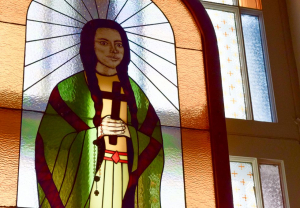Lilly of the Mohawks (1656 – 1680)
Ontario State Deputy has dedicated the 2023 – 2024 Columbian Year to the Patroness St. Kateri Tekakwitha.

Saintly Woman: St Kateri Tekakwitha. Photo: Twitter.
English writer and philosopher, G. K. Chesterton, once remarked that God raises up saints for the people to imitate. That said, they are not usually what the people want, but rather what they most need. Kateri Tekakwitha (baptized Catherine), known as the “Lily of the Mohawks,” the first North American Aboriginal person to be elevated to sainthood, is one of those holy women. The need to dedicate Bruce’s term to this Saint is evident from the fact that hundreds of years after her death, her reputation for holiness continues to grow.
“Kateri Tekakwitha (baptized Catherine), known as the “Lily of the Mohawks,” the first North American Aboriginal person to be elevated to sainthood, is one of those holy women.”
It is in the area of personal holiness that Saint Kateri can teach us much about personal holiness and our need always to strive to be better. Under his term, members of the Order throughout the province who will be gathering are encouraged to honor God by honoring her.
How is it that St. Kateri’s life has prospered and grown with the years? Could it be that she has a providential role to play these days following the Truth and Reconciliation Commission? It is in the area of personal holiness that Saint Kateri can teach us about personal holiness and how we may also strive to be saints.
Background

Stained glass of Shrine of St Kateri Tekakwitha (Kahnawake). Photo: https://www.glassincanada.org/
Every year, an estimated 25,000 people visit a little shrine in Kahnawake, (near Montréal) dedicated to Saint Kateri. It is estimated that more than 300 books in 20 languages have been written about Saint Kateri since her death. Not to mention that several High Schools in Ontario are dedicated to her. So, her story deserves mention here.
Her life was both short and relatively “normal” and unremarkable. What really stood out occurred at the time of her death when witnessed noticed something very unusual – her transfiguration. Since then, thousands of “miracles” have been claimed by pilgrims to the site.
It is known that she was born in 1656 in an Iroquois village called “Ossernon” (now Auriesville, New York). Her father was an Iroquois chief. Her mother, an Algonquin from Trois-Rivières, Québec, had been taken prisoner by the Chief during one of their tribal wars and subsequently married her.
Saint Kateri’s tribe was decimated by smallpox between 1661-1662. Her father, mother, and younger brother all died from the disease leaving her an orphan. She survived but was permanently scared all over her face as a result. Her eyes were so weakened from the disease that she had to wear a blanket (shawl) over her head to keep direct sunlight away from her eyes for the rest of her life.

She was given the Christian name of Catherine in honor of Catherine of Siena, a 15th-century Italian mystic. EA / A. DAGLI ORTI / Getty Images
In 1666, her village was burned down by French Forces during a punitive expedition. So, she went to live with her aunt and uncle, a Mohawk Chief in Fonda, N.Y. Following the arrival of three Jesuit missionaries, one of whom was Jacques de Lamberville, Saint Kateri asked to be baptized a Christian. What followed was 6 months of indoctrination and her baptism on April 18th, 1676. She was 20 years old. She was given the Christian name of Catherine in honor of Catherine of Siena, a 15th-century Italian mystic. Following her conversion, her adoptive parents and her tribe ridiculed her and called her “the Christian” which, at that time, was a term of disdain[1]. She also refused to accept any arranged marriages and worked on Sundays[2]. At times, she was pelted with rocks, and mud, deprived of food, and jeered. She was subsequently threatened with torture. One year after her conversion to Christianity she fled her village.
She fled her home, with the help of a visiting Oneida Chief in 1677. She made her way to the St. Francis Xavier Mission at Sault St. Louis, New France, now Kahnawake, Quebec which was a haven for First Nations who had accepted the Christian Faith. On March 25th, 1979, she asked the mission priest Father Pierre Cholenec (1641-1721) to administer her vow of perpetual chastity thus becoming the first native-born North American Aboriginal maiden to do so[3].
While at the mission, she could often be seen walking barefoot and in chains in the snow to prove her devotion. Other times, she would engage in self-flagellation. Father Pierre Cholenec mentioned in a confidential letter to his superiors that Catherine was surrounded by a mysterious light during these sessions of self-flagellation. Her intense version of Catholic mystic asceticism also included frequent fasts, swimming in the St-Lawrence River in the winter, and placing hot coals between her toes until they burned out[4].
In the Spring of 1680, she predicted that she would die during Holy Week[5]. She died on Holy Sunday, April 17th, 1680. Father Cholenec, her confessor, who had also witnessed her death wrote: “But within a few minutes of her death, she became, almost instantly, very beautiful and fair.[6]” By 1715, Father Cholenec wrote that all French people and Aboriginals had a great veneration for her, calling her Saint Kateri, and many had been healed on the spot. Her remains came to rest in St. Francois Xavier Church in Kahnawake in 1717. From there a group took half of her remains to St. Regis, Quebec (now called Akwesasne). Regrettably, the Catholic church in Akwesasne burned and the relics were destroyed with it in the fire[7].
“But within a few minutes of her death, she became, almost instantly, very beautiful and fair.” Father Cholenec, Saint Kateri’s confessor”
Father Claude Chauchetière (1645-1709), who also worked at the mission wrote: “Everything which she had touched, for example, the crucifixion which he had in her hand when they buried her, has served to work cures. Even her coverlet, the earth around her tomb, the little plate from which she ate, have wrought certain healings.[8]”
She was so revered in the area around Montréal, that even the gigantic Saint Lawrence Seaway construction plans had to work around and avoid disturbing her burial site which was relatively close to the Saint Lawrence River[9].
Sainthood
She passed the first step toward sainthood on January 3rd, 1943 when Pope Pius XII bestowed the title of venerable upon her. Pope John Paul II beatified her on June 22nd, 1980.
December 19th, 2011, Pope Benedict XVI acknowledged a miracle attributed to Catherine, that of healing a young boy in Washington State in 2006. The boy, Jake Finkbonner, had contracted necrotizing fasciitis; also known as “flesh-eating disease” and was cured after Saint Kateri was asked to intervene through prayer and holding a relic of her to his chest. On October 21st, 2012, Catherine was elevated to sainthood and became the first North American Aboriginal person to be canonized.
“December 19th, 2011, Pope Benedict XVI acknowledged a miracle attributed to Catherine, that of healing a young boy in Washington State in 2006”
Saint Kateri is not Canadian, and she is not American. She is North American because she was part of both the Algonquin and Mohawk tribes which were part of the Six Nations Iroquois Confederation which had, at its apex, run from the shores of the Saint Lawrence River to the Laurentian mountains to the North and Albany, N.Y. to the South.
Her feast day, 17 April, was entered into the liturgical calendar of the Catholic Church in 1980.
Visit the St. Kateri Shrine here, proceeds goes to this Shrine
[1] “The Lilly of the Mohawks” St. Louis Dispatch (Saint Louis, Missouri) February 19, 1956, p. 122.
[2] “The Saints Among Us” The Ottawa Citizen, 13 October 1997, p. 4.
[3] “Humble Indian Maid May Become a Saint”. The Ottawa Citizen, 25 January 1961, p. 30.
[4] “Mohawk Tekakwitha to be Canada’s first Aboriginal saint” The Ottawa Citizen. 20 December 2011, p. 3.
[5] “Humble Indian Maid May Become a Saint”. The Ottawa Citizen, 25 January 1961, p. 30.
[6] “Pray Indian Maiden Will Be Canonized.” The Ottawa Citizen, 26 July 1956, p. 30.
[7] “Kateri’s Long Road to Sainthood”. The Ottawa Citizen, 20 October 2012, p. 53.
[8] “The Lilly of the Mohawks” St. Louis Dispatch (Saint Louis, Missouri) February 19, 1956, p. 122.
[9] “Humble Indian Maid May Become a Saint”. The Ottawa Citizen, 25 January 1961, p. 30.
